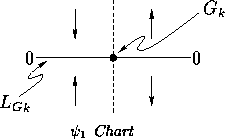




Next: 3.2.4 Constant Functions
Up: 3.2 Constant Interval Arithmetic
Previous: 3.2.2 Interpolating Polynomials
Consider the following chart:
The  chart is used to predict the sign of
chart is used to predict the sign of  ,
for
,
for  , given
, given  .
The chart divides
.
The chart divides  into six disjoint regions, as listed below.
into six disjoint regions, as listed below.
- The forbidden region, indicated above by a dashed line.
The point (x,y) may not reside in the forbidden region,
since G is a function.
The remaining five regions are each labelled with a member of
 .
. - The zero region, indicated above by a solid line, and labelled
with 0.
- Two up regions, each labelled with
 .
. - Two down regions, each labelled with
 .
.
If the point (x,y) resides in a region labelled with
 , then
, then  .
.
The rules for constructing a  chart are as follows:
chart are as follows:
-
The forbidden region, where
 ,
is indicated by a dashed line.
,
is indicated by a dashed line. -
The zero region, where
 , is labelled with 0.
The zero region, along with the forbidden region divide the remainder of
, is labelled with 0.
The zero region, along with the forbidden region divide the remainder of  into a checkerboard of regions.
into a checkerboard of regions. -
The upper right region is an up region, labelled with
 .
. -
The remaining regions are up and down regions, labelled with
 and
and  in checkerboard fashion, as shown above.
in checkerboard fashion, as shown above.
These rules work for any  chart, and are
defended in section
chart, and are
defended in section  .
There is a special case; when
.
There is a special case; when
 the sign of
the sign of  is arbitrary.
This is forbidden with the above rules, since
is arbitrary.
This is forbidden with the above rules, since
 .
These undercontrained cases are not important to us.
.
These undercontrained cases are not important to us.





Next: 3.2.4 Constant Functions
Up: 3.2 Constant Interval Arithmetic
Previous: 3.2.2 Interpolating Polynomials

![]() chart are as follows:
chart are as follows: